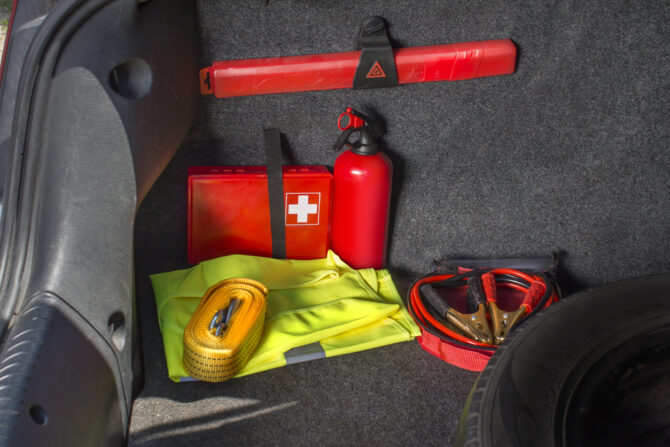
As winter approaches, it’s crucial to ready your vehicle for the challenges posed by icy roads, snowstorms, and plummeting temperatures. Winter driving demands heightened attention and thorough preparation to safeguard both your safety and the longevity of your vehicle.
Below are seven indispensable strategies for readying your vehicle for winter conditions.
1. Inspect Your Tires
Ensuring that your tires are in peak condition stands as a paramount measure in winterizing your vehicle. Cold temperatures can lead to a drop in tire pressure, so it’s essential to regularly check and adjust it to the recommended levels.
To optimize your vehicle’s performance in winter conditions, contemplate acquiring tires specifically engineered for icy and snowy environments. These winter tires feature deeper treads and special rubber compounds, providing improved traction and enhanced grip.
This proactive investment in tire quality is a key measure toward a safer and more secure winter driving experience. If you’re gearing up for winter, make sure to shop tires for winter driving that meet the demands of challenging road conditions.
2. Examine Your Battery

Source: lifehacker.com
Challenging conditions arise for your vehicle’s battery in cold weather. As temperatures decrease, the chemical reactions occurring within the battery decelerate, leading to a diminished overall capacity. Before the winter season arrives, schedule a professional battery test to ensure it holds a proper charge.
If your battery has been in use for multiple years, it would be prudent to contemplate a replacement, as older batteries often encounter increased challenges when operating in colder temperatures.
It’s essential to emphasize that a fully charged battery is not only necessary for starting your vehicle but also plays a pivotal role in ensuring reliable performance, especially in freezing conditions.
3. Top-Up Fluids
Winter weather can be harsh on your vehicle’s fluids, necessitating a thorough check and topping off of essential liquids. It is imperative to conduct a thorough examination of the levels of engine oil, transmission fluid, brake fluid, and antifreeze.
Verify that your windshield washer fluid is specifically formulated for freezing temperatures and ensure the reservoir is consistently full.
By meticulously maintaining optimal fluid levels, you not only enhance the efficiency of your vehicle but also fortify its ability to operate seamlessly in cold weather conditions, safeguarding both its performance and your safety on winter roads.
4. Replace Worn Wiper Blades
Clear visibility is of utmost importance during winter driving, and the pivotal role of your wiper blades cannot be overstated in ensuring an unobstructed view. If your wiper blades are worn or cracked, replace them before winter weather sets in.
Contemplate the acquisition of wiper blades specifically tailored for winter conditions, adept at managing ice and snow to enhance visibility in adverse weather conditions. These specialized blades are crafted with materials that resist freezing, ensuring reliable performance in challenging winter conditions.
Prioritizing this aspect of vehicle maintenance contributes significantly to your safety by guaranteeing an unobstructed view, reducing the risk of accidents, and enhancing overall driving confidence during winter’s unpredictable weather.
5. Prepare an Emergency Kit

Source: neighbor.com
While mechanical preparation is essential, it’s equally crucial to be ready for unexpected situations on the road. Compile a comprehensive emergency kit, including essential items such as a blanket, additional warm clothing, a flashlight, non-perishable snacks, and a first aid kit.
Maintaining this kit in your vehicle throughout the winter season is essential. It can be indispensable in scenarios involving breakdowns, accidents, or sudden weather-related challenges, offering vital supplies and fostering peace of mind during unforeseen circumstances on the road.
6. Inspect Lights and Signals
Winter compromises visibility with shorter days and often inclement weather, making it imperative to prioritize lighting on your vehicle. Ensure the operational integrity of all lighting elements, including headlights, brake lights, and turn signals.
Regularly clean the lenses and promptly replace any burned-out bulbs. Adequate lighting not only enhances your vision but also plays a crucial role in ensuring that other drivers can see you clearly, significantly reducing the risk of accidents on the road, especially during the challenging conditions that winter brings.
7. Evaluate Your Brakes
Brakes are paramount for safe winter driving. Schedule a thorough inspection of your brake system to ensure the brake pads, rotors, and other components are in optimal condition. If you detect any unusual noises or experience difficulty when braking, address the issue promptly.
Properly functioning brakes are not only essential for maintaining control on slippery roads but also play a crucial role in preventing accidents, providing you with the confidence and responsiveness needed for navigating challenging winter conditions.
Regular brake maintenance is a proactive measure designed to ensure not only your personal safety but also the welfare of fellow road users.
Conclusion

Source: regionalmedicalgroup.com
Preparing your vehicle for winter driving is a proactive measure that significantly enhances your safety and your vehicle’s performance during the colder months. By following these seven tips, you’ll be better equipped to navigate winter roads with confidence and reduce the risk of weather-related issues.
Remember that a well-maintained vehicle not only ensures your safety but also contributes to the longevity and efficiency of your car. Stay safe on the roads this winter!



